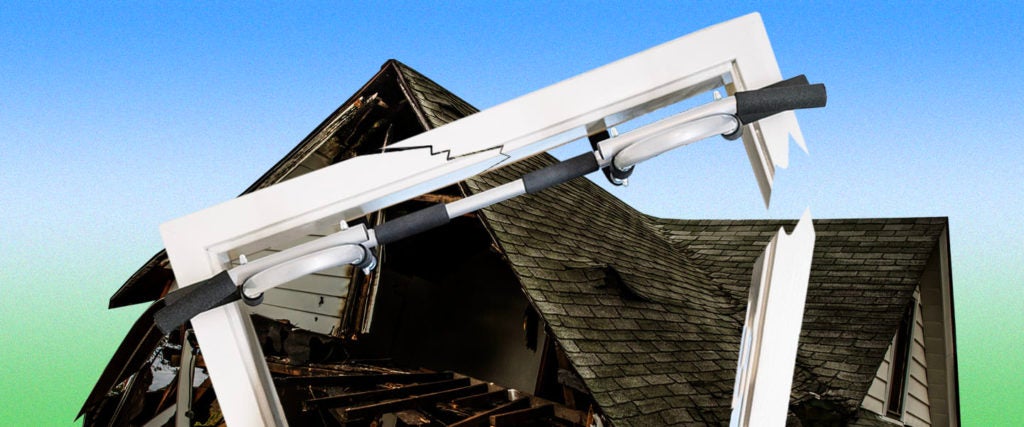If there’s anything close to a certainty in the home-fitness world, it’s that you should expect to pay double or triple the cost of your actual pull-up bar to repair the damage that bar will administer to the doorway to which you adhere it. It’s a shame that there’s really no other rational choice short of purchasing a massive training rack to stash in your garage, or drilling unsightly holes in the wall and bolting in a piece of iron that looks like it was pounded into shape by Asgardian blacksmiths. Man caves are one thing, but a giant pull-up bar will have your basement looking more like a vigilante hideout inside of an abandoned warehouse.
And so, a doorway truly is the most reasonable place to hang a pull-up bar in most homes, and this reality is reflected by the vast number of doorway hanging pull-up bar options available on the market today.
How do I get a pull-up bar that won’t destroy my doorway?
It sounds to me like you’re looking for the pull-up bar equivalent to a unicorn.
The belief that a door-hanging pull-up bar somehow won’t damage your doorframe was popularly fostered by the Iron Gym company, along with their commercial that very specifically articulated the promise that no damage would befall your “door” through the use of their pull-up product. The commercial used every shred of Fred-Astaire-level skill and agility to tap dance around the distinction between the “door frame” the Iron Gym wraps around, and the “door” that won’t be damaged. In essence, because they only ever promised that your literal door would go undamaged, the Iron Gym is free to dent, depress, bend and crack other elements of your doorway with impunity, and it will certainly do that.
The corporate dodge goes deeper than that, too, because the part of the doorway most likely to be damaged by the Iron Gym is neither the door nor the frame; it’s the architrave, or the decorative door lining that sits off on its own. Essentially, the Iron Gym company made no promises regarding the safety of the only portions of the doorway that the Iron Gym makes physical contact with.
You can’t really blame architrave manufacturers for the regularity with which their craftsmanship breaks down beneath the weight of 200-pound men. Until roughly a decade ago, I’m sure they never gave any thought to the idea that full-sized humans would one day be theoretically risking permanent injury by suspending the full weight of their bodies from the architrave of a doorway, which in some cases is barely a couple centimeters thick. In that respect, the blame for any damage to the decorative frame outside of your actual door should be laid squarely at the feet of the bar — and also yourself. After all, you’re not exactly weightless.
So they’ll all destroy my doorway?
To an extent, yes. Again, the architrave of a door was never intended to have people dangling from it several times each week, all the while applying tremendous downward pressure to it. That pressure may be somewhat mitigated by the placement of the horizontal bar that braces against the vertical section of the architrave, but this is also likely to leave a nice indentation in those side panels over time.
Keep in mind, most of the alternatives are worse. I’m sure there are some people who have had success with the pull-up bars that brace against the actual frame of your doorway through a twisting motion. Supposedly, the downward tug is intended to smoothly lock the bar nearly into place within the frame, but the bar has always slid downward on me. As a result, I’ve overcompensated by twisting the bar extra tight, and bent or broken the door frame in the process. To me, there’s no contest: If I’m forced to choose between a dented architrave and a broken door frame, I’m going to sacrifice the architrave every time.
Okay, I get it — there’s nothing I can do to prevent the damage from occurring.
The best hope I’ve seen for minimizing overall damage to doorways is a set of CrossGrips from JayFlex Fitness.
I’m providing this recommendation with slight reluctance for two reasons. First, the widest grip you can achieve with a pair of CrossGrips is limited by the overall width of the doorway you’re working within, which means you can’t achieve the ideal lat-building grip width that you’d have access to through the use of some other bars that extend the handles out and away from the door. Also, one of my CrossGrips broke, because a lot of pressure is placed on the handles with relatively little area for all of the pressure to be distributed across the top of the architrave. To their credit, the JayFlex company was very diligent about providing me with a replacement handle.
All things considered, the CrossGrips isolate all of the architrave damage to the topmost section, making it the pull-up handles that are least likely to cause conspicuous damage to your doorway.
But there’s no magical door you can walk through where it will be inconspicuous.

